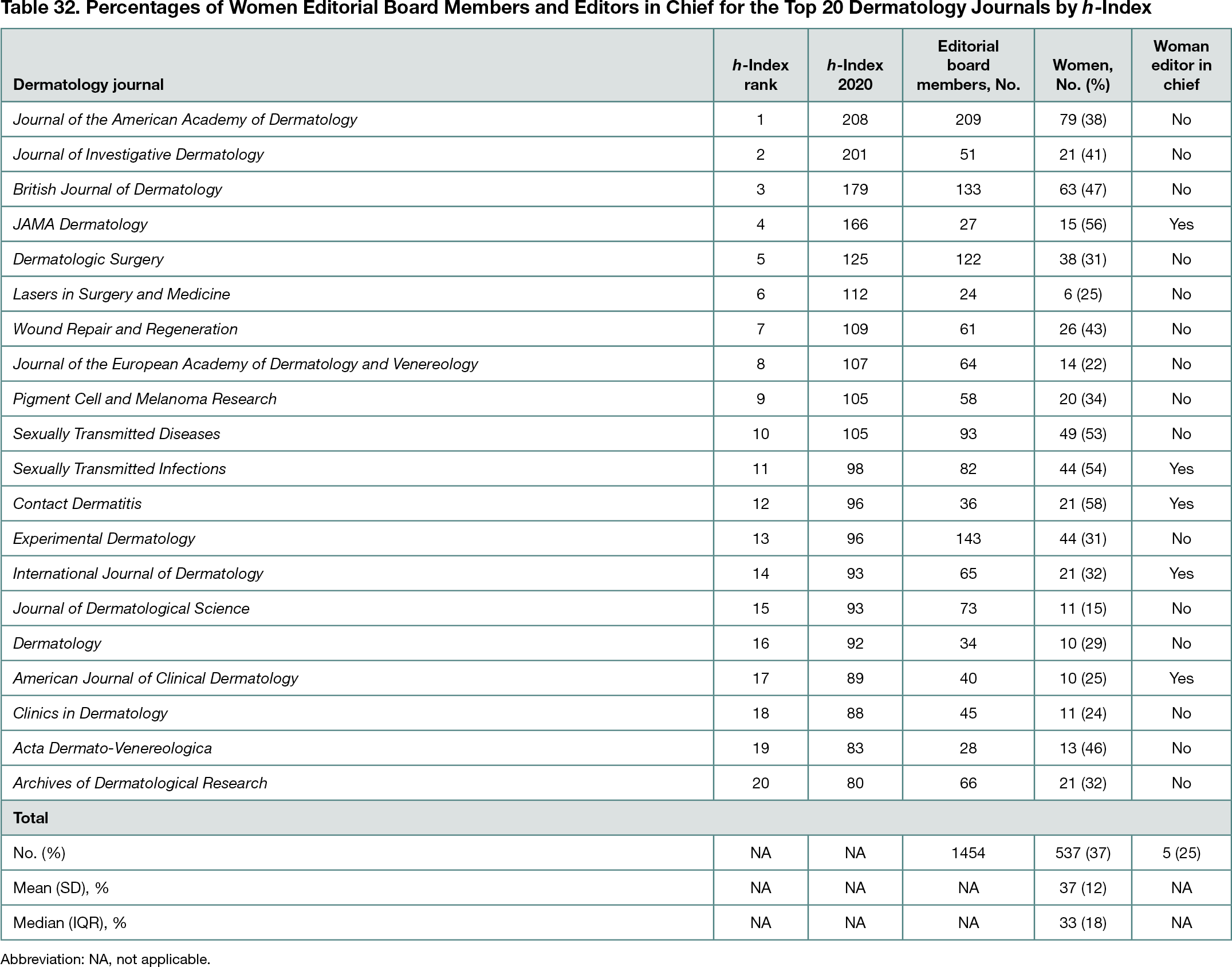Abstract
Analysis of Editorial Board Gender Parity of the Top 20 Most Influential Dermatology Journals
Mindy D. Szeto,1 Torunn E. Sivesind,2 Lori S. Kim,3 Katie A. O’Connell,4 Kathryn A. Sprague,5 Yvonne Nong,6 Daniel M. Strock,7 Annie L. Cao,8 Jieying Wu,9 Lauren M. Toledo,10 Sophia M. Wolfe,11 Wyatt Boothby-Shoemaker,12 Robert P. Dellavalle13
Objective
Women continue to be underrepresented in academic leadership positions, especially in dermatology.1 Although women account for more than half of all board-certified dermatologists in the United States, academic dermatology leadership roles, such as department chair and fellowship director positions, remain disproportionately occupied by men.2 Available evidence suggests that this inequity extends to medical journals, with substantial gender gaps reported in editorial board composition across multiple specialties. Previously published data from 2018 suggested that women accounted for the minority of dermatology editors in all positions.1 To provide an update to this work and an evaluation of current trends, the gender distribution of dermatology editorial boards was assessed in 2021, making comparisons among the top 20 most influential dermatology journals.
Design
The top 20 dermatology journals by 2020 h-index were identified on Scimago.3 Journal editorial board websites were searched in November 2021 for lists of editor names and roles, and journal-defined editorial board members were collected and tabulated. Binary (women vs men) gender estimation by author first name was performed with Gender API, a popular gender inference service based on querying large multifactorial databases and name repositories. Estimations were corroborated by online searches of professional photographs and biographies by 2 independent reviewers, with in-depth discussion and consensus meetings to resolve discrepancies.
Results
Women made up a mean (SD) of 37% (12%) and a median (IQR) of 33% (18%) of editorial boards across the top 20 dermatology journals (Table 32). The Journal of Dermatological Science (15%) and Journal of the European Academy of Dermatology and Venereology (22%) had the lowest proportion of women editors, while Contact Dermatitis (58%), Sexually Transmitted Infections (54%), and Sexually Transmitted Diseases (53%) had among the highest. The editorial board of JAMA Dermatology was observed to be 56% women after excluding International Advisory Committee members. Of the 20 journals, 5 journals (25%) had women editors in chief.
Conclusions
This study found that underrepresentation of women on dermatology journal editorial boards persisted across multiple top journals. The finding suggests that editors in chief and journal leadership should consider establishing board member recruitment targets with the goal of gender parity. A target of 50% women on boards could more accurately represent the dermatology workforce. Limitations of our study include reliance on high-throughput software analyzing first names only and estimating binary gender, which may lead to misclassification. Future work should consider self-reported sex and gender identity to ensure true concordance with the individual’s identity. Addressing gender gaps and encouraging diversity of identity and perspectives among editorial boards is a worthwhile goal for further research.
References
1. Lobl M, Grinnell M, Higgins S, Yost K, Grimes P, Wysong A. Representation of women as editors in dermatology journals: a comprehensive review. Int J Womens Dermatol. 2019;6(1):20-24. doi:10.1016/j.ijwd.2019.09.002
2. Nambudiri VE, Shi CR, Vleugels RA, Olbricht SM. Academic dermatology leadership in the United States—addressing the gender gap. Int J Womens Dermatol. 2018;4(4):236-237. doi:10.1016/j.ijwd.2018.05.003
3. SJR Scimago Journal & Country Rank. Accessed November 30, 2021. https://www.scimagojr.com/journalrank.php
1Department of Dermatology, University of Colorado Anschutz Medical Campus, Aurora, CO, USA, mindy.d.szeto@gmail.com; 2Department of Dermatology, University of Colorado Anschutz Medical Campus, Aurora, CO, USA; 3University of Illinois at Chicago College of Medicine, Chicago, IL, USA; 4Eastern Virginia Medical School, Norfolk, VA, USA; 5Chicago College of Osteopathic Medicine, Downers Grove, IL, USA; 6Michigan State University College of Human Medicine, Flint, MI, USA; 7Eastern Virginia Medical School, Norfolk, VA, USA; 8Department of Dermatology, University of Colorado Anschutz Medical Campus, Aurora, CO, USA; 9Rocky Vista University, Parker, CO, USA; 10Lake Erie College of Osteopathic Medicine, Bradenton, FL, USA; 11Department of Dermatology, University of Colorado Anschutz Medical Campus, Aurora, CO, USA; 12Michigan State University College of Human Medicine, East Lansing, MI, USA; 13Department of Dermatology, University of Colorado Anschutz Medical Campus, Aurora, CO, USA
Conflict of Interest Disclosures
Robert P. Dellavalle is a joint coordinating editor for Cochrane Skin, a dermatology section editor for UpToDate, a social media editor for the Journal of the American Academy of Dermatology, a podcast editor for the Journal of Investigative Dermatology, editor in chief of JMIR Dermatology, and a coordinating editor representative on Cochrane Council. Torunn E. Sivesind serves as an editorial board member at large for JMIR Dermatology and receives fellowship funding from Pfizer. The remaining authors have no conflicts of interest to declare.

